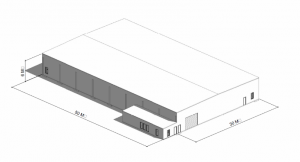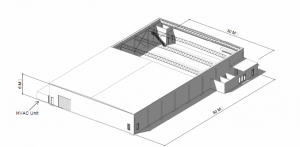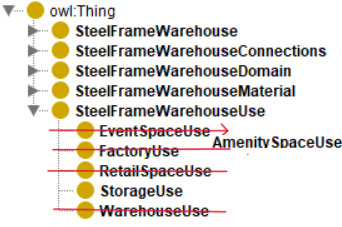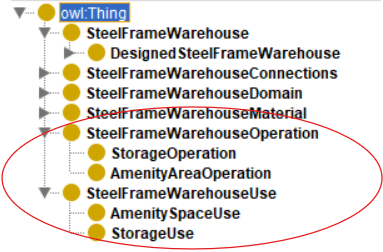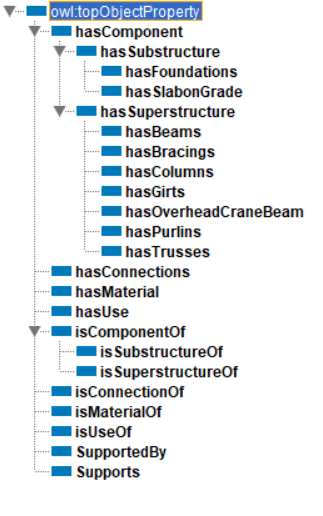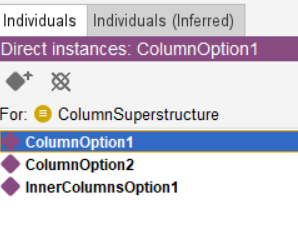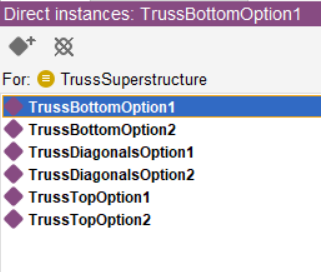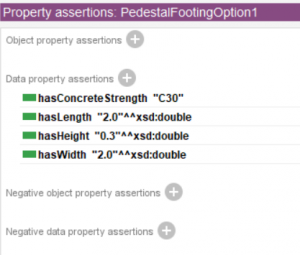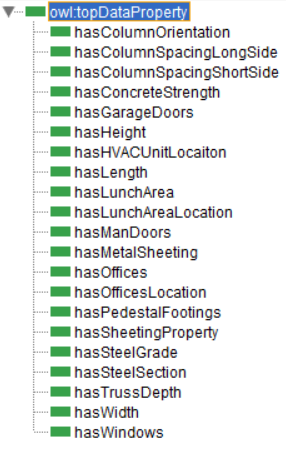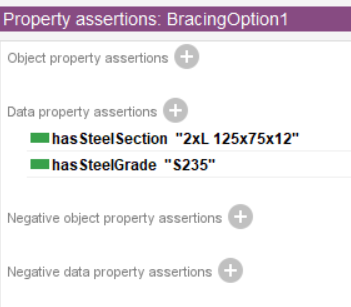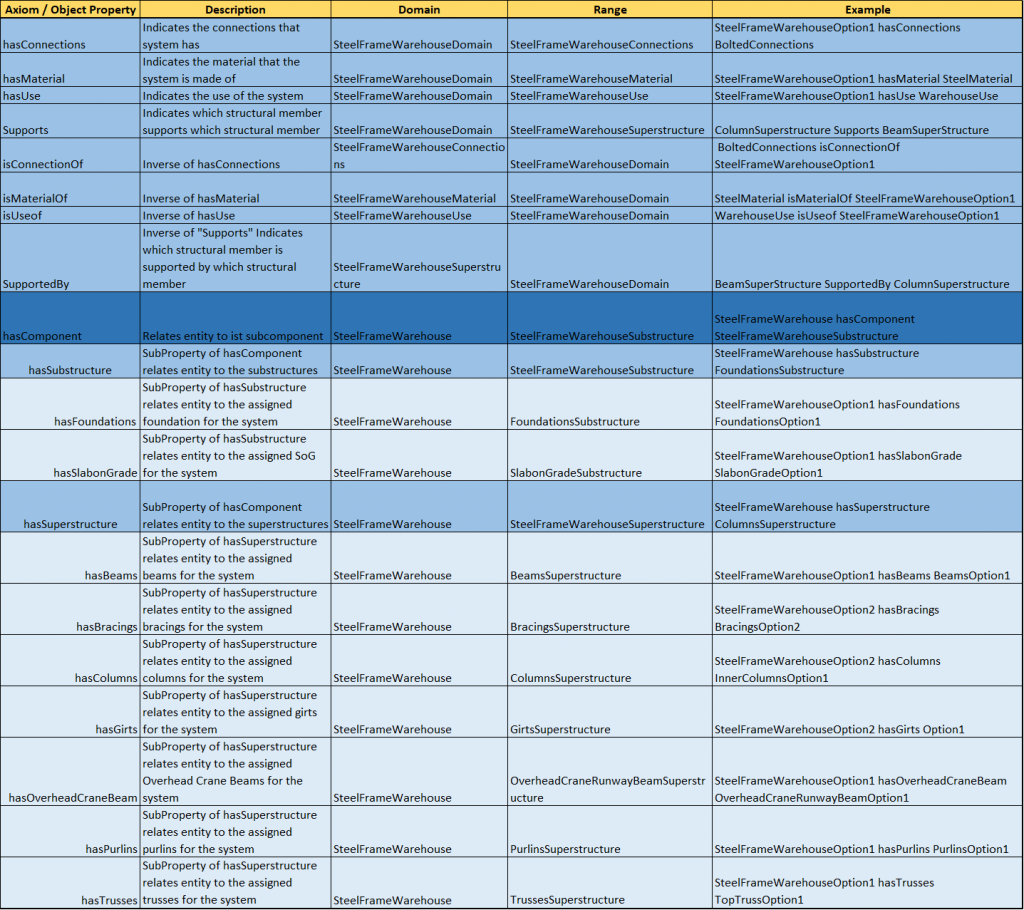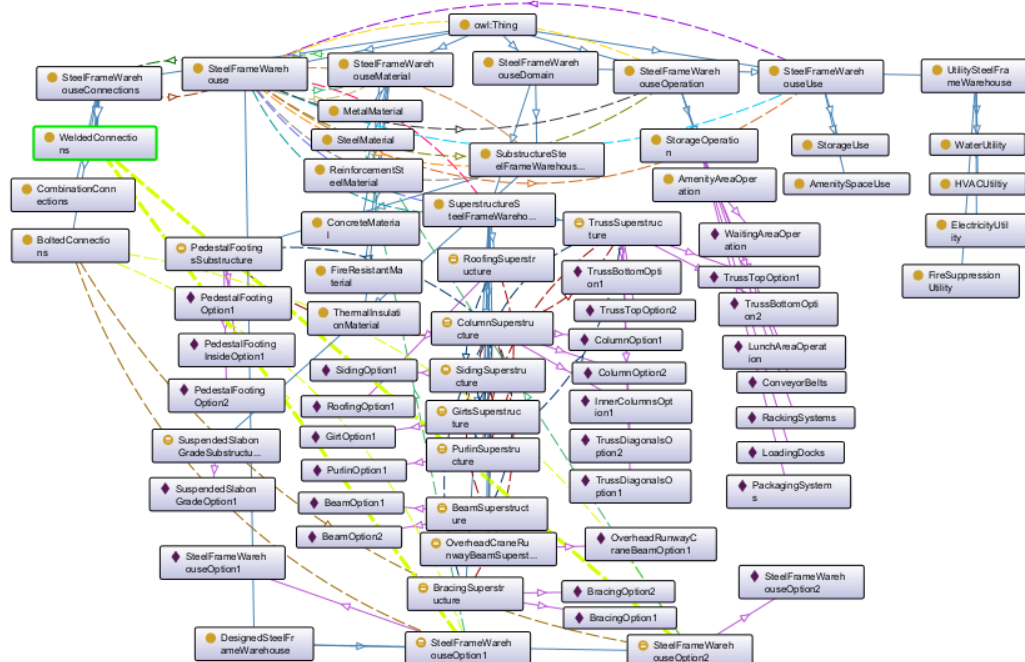Introduction
The aim of this ontology is to provide an ontological framework for the structural design of a typical steel frame warehouse building. This ontology offers a structured and logical framework for representing the system’s structural components and relationships in consideration of the facility’s intended use.
According to Rob O`Bryne from LogisticsBureau, one of the key aspects of designing an industrial building is identifying the use and designing the structure to serve that purpose. Industrial facilities need to adapt to future needs to keep optimization, remodeling, and addition costs at a minimum. (Wei, 2019). So, this ontology is built to help the design team and the future design teams that will work on this facility understand the initial considerations made and the reasonings behind the design process.
This building had possible use of multiple options but regardless of the use of it, having the maximum space with least possible interactions in the factory was considered. Therefore, the inner space was left column free. This would help with any type of industrial or social use of the warehouse structure. Even if building is a warehouse, industrial factory, retail space, or an amenity area (event space, a club, restaurant) for each option this is a valuable aspect to have, allowing the occupants to freely modify it for their own use, and also providing immense adaptability for future renovations or change of uses.
Scope of the Ontology
As discussed in Noy and McGuiness’s “Ontology Development 101: A guide to creating your first ontology.”, an ontology can be developed further and further but then the complexity and the clarity of it will decrease. Therefore, defining the limits of an ontology is important. Provided ontology is strictly for the structural design of the facility to accommodate the needs of the building.
Intended Users
- Warehouse design teams of engineers and architects,
- Construction teams of consultants and construction engineers,
- Stakeholders of similar projects.
Intended Use
- Provides a structured and logical framework to represent the system’s components, their relationships, and functions to support integration with computational tools and to support design teams.
- It maps out the interdependencies among structural elements, the rationale behind their selection, the overall layout of the structure, and the range of options considered during the design process. These allow this ontology to act as a common working ground for the stakeholders of the project.
- Lists materials and components needed for the construction of the project.
- Moreover, if the building’s purpose changes in the future, the ontology can help identify which components can be modified to adapt the structure to its new function.
- Providing a base for engineers and designers with limited experience in these types of facilities
The Role It Plays in the Integrated Ontology for the Industrial Complex
As mentioned above the use of the system use can be changed, the building has multiple possible uses. In the context of the integration, since the size of the other two industrial buildings is enormous compared to this building, the design team decided this building to have amenity space and additional storage use. The other two buildings will be the main vehicle repair industrial complexes. Therefore, there have been some adaptations for it.
Example modification: Selected Use for Building and Added Operations for the Use
Initial Modified for Integration
Example modification: Added Structural Components for Selected Operation (Pedestal Footings for Conveyor Belts)
Please see the full ontology uploaded to this website for further details.
Building the Ontology
1. Domain
This ontology focuses on the domain of steel frame industrial warehouses, so the warehouse serves as the concept being modeled.
2. Classes and Sub-classes:
DesignedSteelFrameWarehouse: Possible design options for any given project.
SteelFrameWarehouseConnections: Connection types that can be used between the steel components of the structural frame.
SteelFrameWarehouseDomain: In the main domain, the structural frame is divided into two subclasses; substructure and superstructure.
SteelFrameWarehouseMaterial: Materials that are used for the structural components.
SteelFrameWarehouseOperation: Operational components needed for the selected use.
SteelFrameWarehouseUse: Selected uses for the structure.
3. Object Properties:
Object properties define the relationships between the classes. The relationship that each of these object properties defines will be explained in the Axiom table.
4. Individuals:
In this step, the specific examples start to come into play. For an ontology, individuals (also referred to as instances) represent the examples or the concepts defined within the ontology. Their mission is to serve as the real-world manifestations of abstract concepts and play a crucial role in grounding the ontology in reality. Therefore, in this section, we start to put some structural components for our example structure.
5. Data Properties:
Data properties enable the user to define attributes to the instances and classes by various selections of input types. This is the section, that the ontology discussed in this paper is quantified, and shaped.
Using these data properties on the left, the properties for the individuals that are used for our subclasses and classes are defined.
A couple of examples are shown below:
6. Axiom Table
Table 1: Axiom Table
7. Final Ontograph
Engineering Examples for the Ontology
- Computational Uses
This ontology can formulate the structural design of a warehouse building, also with the use of section data properties and material information, it can be used as a tool to estimate the overall quantities of the materials in between different design options that are developed
- Renovation of the Building into a Different Use
In the case of an architectural or structural renovation, the new design team can use this ontology to understand the initial design criteria and reasonings. Depending on the new use, the ontology can be a base starting point for the reconstruction or demolition that is needed to fit the purpose.
- Being a Data Transfer System between Stakeholders
Construction team engineers or consultant firms can use this ontology to understand the design development process, the key points of the design, and the sensitivities of the design team or the client. The ontology can be developed further as the project goes on to satisfy different methodological needs.
- Supporting the Design Teams
The ontology can be a basic guide for the design teams that have limited experience in the steel frame warehouse structures on how to develop their model
References
- “Key Considerations in Warehouse Design and Layout.” SIPMM Publications, 13 Nov. 2023, publication.sipmm.edu.sg/key-considerations-warehouse-design-layout/
- Warehouse Layout Design Principles.” Logistics Bureau, 15 Nov. 2023, logisticsbureau.com/warehouse-layout-design-principles
- Noy, Natalya F., and Deborah L. McGuinness. “Ontology development 101: A guide to creating your first ontology.” (2001).
- Krötzsch, Markus, Frantisek Simancik, and Ian Horrocks. “A description logic primer.” arXiv preprint arXiv:1201.4089(2012).
- Thande, Harun Mugo. Structural Analysis and Design of a Warehouse Building. Bachelor’s thesis, HAMK University of Applied Sciences, (2014).
- Farias, Arthur Almeida Cordeiro de, et al. “Analysis and Design of Structural Elements of an Industrial Steel Warehouse with Overhead Crane.” International Journal of Engineering Research and Applications, vol. 12, no. 2, (2022).
- Gu, Jinxiang, Marc Goetschalckx, and Leon F. McGinnis. “Research on Warehouse Design and Performance Evaluation: A Comprehensive Review.” European Journal of Operational Research, vol. 203, no. 2, 2010, pp. 539–549, https://doi.org/10.1016/j.ejor.2009.07.031.
